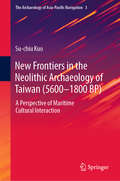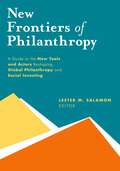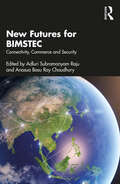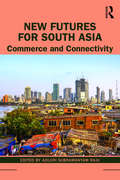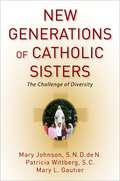- Table View
- List View
New Frontiers in Microsimulation Modelling (Public Policy and Social Welfare)
by Ann HardingIn the past fifteen years, microsimulation models have become firmly established as vital tools for analysis of the distributional impact of changes in governmental programmes. Across Europe, the US, Canada and Australia, microsimulation models are used extensively to assess who are the winners and losers from proposed policy reforms; this is now expanding into new frontiers, both geographically and in terms of policy areas. With contributions from more than 60 international experts, this volume offers a comprehensive introduction to the state of microsimulation internationally, illustrating a wide range of new applications and approaches. It will be of relevance to government policy makers, social policy planners, economists and those concerned with predicting the impact of public policy change and to academics in a variety of disciplines, especially social and public policy, human geography, development studies and economics.
New Frontiers in Microsimulation Modelling (Public Policy and Social Welfare)
by Ann HardingIn the past fifteen years, microsimulation models have become firmly established as vital tools for analysis of the distributional impact of changes in governmental programmes. Across Europe, the US, Canada and Australia, microsimulation models are used extensively to assess who are the winners and losers from proposed policy reforms; this is now expanding into new frontiers, both geographically and in terms of policy areas. With contributions from more than 60 international experts, this volume offers a comprehensive introduction to the state of microsimulation internationally, illustrating a wide range of new applications and approaches. It will be of relevance to government policy makers, social policy planners, economists and those concerned with predicting the impact of public policy change and to academics in a variety of disciplines, especially social and public policy, human geography, development studies and economics.
New Frontiers in Offender Treatment: The Translation of Evidence-Based Practices to Correctional Settings
by Elizabeth L. Jeglic Cynthia CalkinsThis book reviews how new and promising evidence-based interventions are being used with those involved in the criminal justice system. While there has been an increased emphasis on evidence-based practice within forensic treatment, there remains a disjoint between what we know works and adapting these interventions to those involved in the criminal justice system. This book seeks to bridge that gap by providing an overview of what we know works and how that information has been translated into offender treatment. In addition, it highlights avenues where additional research is needed. This book is comprised of three parts:In the first part, current models of correctional treatment including the Risk, Needs, Responsivity Model, The Good Lives Model and Cognitive Behavioral Models are presented. In the second part, the chapters address clinical issues such as the therapeutic alliance, clinician factors, and diversity related issues that impact treatment outcome. In the third and final part of the book, adaptions of innovative and cutting-edge evidence-based treatments such as Dialectical Behavior Therapy, Trauma Informed Care, Mindfulness, Motivational Interviewing, Assertive Community Treatment, Multisystemic Treatment, New frontiers in Intimate Partner Violence treatment, and the current research on the treatment of those with psychopathy are presented. Research supporting these treatment approaches targeting areas such as self-management, psychological well-being, treatment engagement and retention and their relationship to recidivism will be reviewed, while their adaptation for use with forensic populations is discussed. The book concludes with the editors’ summary of the findings and a discussion of the future of evidence-based interventions within the field of forensic psychology.
New Frontiers in Social Innovation Research
by Alex Nicholls Julie Simon Madeleine GabrielThis book is open access under a CC BY license. Interest in social innovation continues to rise, from governments setting up social innovation 'labs' to large corporations developing social innovation strategies. Yet theory lags behind practice, and this hampers our ability to understand social innovation and make the most of its potential. This collection brings together work by leading social innovation researchers globally, exploring the practice and process of researching social innovation, its nature and effects. Combining theoretical chapters and empirical studies, it shows how social innovation is blurring traditional boundaries between the market, the state and civil society, thereby developing new forms of services, relationships and collaborations. It takes a critical perspective, analyzing potential downsides of social innovation that often remain unexplored or are glossed over, yet concludes with a powerful vision of the potential for social innovation to transform society. It aims to be a valuable resource for students and researchers, as well as policymakers and others supporting and leading social innovation.
New Frontiers in Socialization (Advances in Life Course Research #Volume 7)
by Richard A. Settersten Jr. Timothy J. OwensNew Frontiers in Socialization
New Frontiers in Technological Literacy: Breaking with the Past
by John DakersThis book attempts to rethink the concept of technological literacy in a modern context, not only in terms of a subject area taught in schools, but also as an important general concept that all citizens should engage with. As this book will illustrate, the concept of technological literacy has no universally agreed definition.
New Frontiers in the Neolithic Archaeology of Taiwan: A Perspective of Maritime Cultural Interaction (The Archaeology of Asia-Pacific Navigation #3)
by Su-chiu KuoThis book summarizes the systematic research on the Neolithic cultures of Taiwan, based on the latest archaeological discoveries, and focusing on the maritime interactions between mainland southeast China, Taiwan, and southeast Asia during (5600-1800 BP). The study demonstrates and sheds light on the distinctiveness of Taiwan’s Neolithic cultures, their interactions with the external cultures of its surrounding regions, the maritime cultural diffusion and early seafaring across sea regions like the Taiwan Strait, Bashi channel and South China Sea. Drawing on the author’s deep understanding of Taiwan and its surrounding regions, the book also incorporates recent archeological findings by Taiwanese researchers. Further, based on a new reconstruction of the spatiotemporal framework of Taiwanese prehistoric cultures, the chronologically arranged chapters discuss Neolithic cultures of the early, middle, late and final stage of this island region, revealing the prehistoric cultural development, regional typology and their maritime interactions with surrounding regions. The typological study of the native traits and external cultural influences of each stage of Neolithic culture shows the prehistoric and early history of this key stepping stone in the Asia-Pacific region.
New Frontiers Of Philanthropy: A Guide To The New Tools And New Actors That Are Reshaping Global Philanthropy And Social Investing
by Lester M. SalamonNew Frontiers of Space, Bodies and Gender
by Rosa AinleyThis collection unravels the stereotypical images of gender and space and presents a series of new explorations into both 'lived' and 'imagined' spaces. In New Frontiers of Space, Bodies and Gender leading contemporary writers from across an eclectic mix of disciplines, examine an exciting array of issues such as: * Jamaican Ragga music and female performance * Feminist anti-violence work * Pregnant women's experience of shopping centres * The fear of crime felt by women using urban greenspace * Implications of technology in gendering identities This book forges new parameters for debates of gender and space, leaving behind the simple focus on women-as-victim in the public arena and remapping considerations of space which look beyond bricks and mortar. Contributors: Aylish Wood, Robyn Longhurst, Ali Grant, Lesley Klein, Affrica Taylor, Inga-Lisa Sangregorio, Jacqueline Leavitt, Tracey Skelton, Nina Wakeford, Jos Boys, Sally R. Munt, Doreen Massey, Jacquie Burgess, Maher Anjum, Lynne Walker.
New Frontiers of Space, Bodies and Gender
by Rosa Ainley Nfa* Rosa AinleyThis collection unravels the stereotypical images of gender and space and presents a series of new explorations into both 'lived' and 'imagined' spaces. In New Frontiers of Space, Bodies and Gender leading contemporary writers from across an eclectic mix of disciplines, examine an exciting array of issues such as: * Jamaican Ragga music and female performance * Feminist anti-violence work * Pregnant women's experience of shopping centres * The fear of crime felt by women using urban greenspace * Implications of technology in gendering identities This book forges new parameters for debates of gender and space, leaving behind the simple focus on women-as-victim in the public arena and remapping considerations of space which look beyond bricks and mortar. Contributors: Aylish Wood, Robyn Longhurst, Ali Grant, Lesley Klein, Affrica Taylor, Inga-Lisa Sangregorio, Jacqueline Leavitt, Tracey Skelton, Nina Wakeford, Jos Boys, Sally R. Munt, Doreen Massey, Jacquie Burgess, Maher Anjum, Lynne Walker.
The New Fundraisers: Who organises charitable giving in contemporary society?
by Beth BreezeCharitable fundraising has become ever more urgent in a time of extensive public spending cuts. However, while the identity and motivation of those who donate comes under increasingly close scrutiny, little is known about the motivation and characteristics of the ‘askers’, despite almost every donation being solicited or prompted in some way. This is the first empirically-grounded and theorised account of the identity, characteristics and motivation of fundraisers in the UK. Based on original data collected during a 3-year study of over 1,200 fundraisers, the book argues that it is not possible to understand charitable giving without accounting for the role of fundraising.
The New Fundraisers: Who organises charitable giving in contemporary society?
by Beth BreezeCharitable fundraising has become ever more urgent in a time of extensive public spending cuts. However, while the identity and motivation of those who donate comes under increasingly close scrutiny, little is known about the motivation and characteristics of the ‘askers’, despite almost every donation being solicited or prompted in some way. This is the first empirically-grounded and theorised account of the identity, characteristics and motivation of fundraisers in the UK. Based on original data collected during a 3-year study of over 1,200 fundraisers, the book argues that it is not possible to understand charitable giving without accounting for the role of fundraising.
New Futures for BIMSTEC: Connectivity, Commerce and Security
by Adluri Subramanyam Raju Anasua Basu Ray ChaudhuryBIMSTEC (Bay of Bengal Initiative for Multi-Sectoral Technical and Economic Cooperation) represents one of the most diverse regions of the world. Providing a unique link between South Asia and Southeast Asia, it brings together 1.5 billion people and a combined GDP of $2.7 trillion. This volume focuses on issues related to connectivity, commerce, and security challenges facing BIMSTEC. It studies BIMSTEC’s relevance as an inter-governmental organization in the changing international milieu. The volume discusses the necessity of connectivity to enhance Bay solidarity and analyses the political, strategic and security concerns that restrain commercial connectivity. It also looks at the Bay of Bengal region as a zone of competition—and possible collaboration—between the littoral countries and major powers involved in the region. Comprehensive and topical, this volume will be an essential read for scholars and researchers of international relations, South Asian studies, foreign policy, diplomacy, Southeast Asian studies, defence and strategic affairs, maritime studies, international trade, regional cooperation, and political studies.
New Futures for BIMSTEC: Connectivity, Commerce and Security
by Adluri Subramanyam Raju Anasua Basu Ray ChaudhuryBIMSTEC (Bay of Bengal Initiative for Multi-Sectoral Technical and Economic Cooperation) represents one of the most diverse regions of the world. Providing a unique link between South Asia and Southeast Asia, it brings together 1.5 billion people and a combined GDP of $2.7 trillion. This volume focuses on issues related to connectivity, commerce, and security challenges facing BIMSTEC. It studies BIMSTEC’s relevance as an inter-governmental organization in the changing international milieu. The volume discusses the necessity of connectivity to enhance Bay solidarity and analyses the political, strategic and security concerns that restrain commercial connectivity. It also looks at the Bay of Bengal region as a zone of competition—and possible collaboration—between the littoral countries and major powers involved in the region. Comprehensive and topical, this volume will be an essential read for scholars and researchers of international relations, South Asian studies, foreign policy, diplomacy, Southeast Asian studies, defence and strategic affairs, maritime studies, international trade, regional cooperation, and political studies.
New Futures for South Asia: Commerce and Connectivity
by Adluri Subramanyam RajuThis book is a comprehensive examination of the society, polity and economy of South Asian countries and their future trajectories. The chapters included in the volume present key insights into the geopolitical dynamics of the region. New Futures for South Asia: draws on case studies from the region to discuss how democracy has fared in terms of state-society linkages, transformational possibilities and the globalization and radicalization of politics; studies possibilities of economic cooperation in South Asia, including common currency, regional imbalances and aid, transport connectivity and electricity consumption; examines the crucial role of SAARC and bilateralism in forging connectivities across the diverse geographies of the region. A major intervention in re-shaping South Asian studies, this book will be a great resource for scholars and researchers of security studies, strategic affairs, international relations, development studies and politics.
New Futures for South Asia: Commerce and Connectivity
by Adluri Subramanyam RajuThis book is a comprehensive examination of the society, polity and economy of South Asian countries and their future trajectories. The chapters included in the volume present key insights into the geopolitical dynamics of the region. New Futures for South Asia: draws on case studies from the region to discuss how democracy has fared in terms of state-society linkages, transformational possibilities and the globalization and radicalization of politics; studies possibilities of economic cooperation in South Asia, including common currency, regional imbalances and aid, transport connectivity and electricity consumption; examines the crucial role of SAARC and bilateralism in forging connectivities across the diverse geographies of the region. A major intervention in re-shaping South Asian studies, this book will be a great resource for scholars and researchers of security studies, strategic affairs, international relations, development studies and politics.
The New Futures of Exclusion: Life in the Covid-19 Aftermath
by Daniel Briggs Luke Telford Anthony Lloyd Anthony EllisBased upon global data and following on from Lockdown: Social Harm in the COVID-19 Era, this book discusses the rise of surveillance capitalism and new forms of control and exclusion throughout the Covid-19 pandemic. It particularly addresses the use of vaccine passports, mandates and the new forms of capital extraction and political control that emerged throughout the pandemic. The book also explicates how the ‘vaccine hesitant’ became marginalized in both mainstream discourse and through regulatory interventions. Whilst the book addresses the wider political economy within which so-called ‘anti-vaxxers’ were ostracized, it also explores the complex nature of their sentiments. The book closes by considering The New Futures of Exclusion, outlining the forms of surveillance and control that may be implemented in the future particularly in light of the challenges brought by global warming and the energy transition. It is a broadly accessible text, particularly appealing to policymakers, general readers and academics in sociology, political sociology, politics, human geography, political economy, criminology, social policy, psychology, history, and infectious diseases and medicine.
New Games: Postmodernism After Contemporary Art (Theories of Modernism and Postmodernism in the Visual Arts)
by Pamela M. LeePamela M. Lee’s New Games revisits postmodernism in light of art history's more recent embrace of "the contemporary." What can the theories and practices associated with postmodernism tell us about the obsession with the contemporary in both the academy and the art world? In looking at work by Dara Birnbaum, Öyvind Fahlström and Richard Serra, among others, Lee returns to Jean-Francois Lyotard's canonical text The Postmodern Condition as a means to understand more recent art-critical interests in interactivity, collectivism and neo-liberalism. She reads Lyotard's well-known treatment of language games relative to the game theory associated with the Cold War and the rise of the information society. New Games asks readers to think critically about our recent past and the embattled state of our contemporary preoccupations. With a critical introduction by Johanna Burton, New Games is the fourth and penultimate volume in Routledge’s series of short books on the theories of modernism by leading art historians on twentieth-century art and art criticism.
New Games: Postmodernism After Contemporary Art (Theories of Modernism and Postmodernism in the Visual Arts)
by Pamela M. LeePamela M. Lee’s New Games revisits postmodernism in light of art history's more recent embrace of "the contemporary." What can the theories and practices associated with postmodernism tell us about the obsession with the contemporary in both the academy and the art world? In looking at work by Dara Birnbaum, Öyvind Fahlström and Richard Serra, among others, Lee returns to Jean-Francois Lyotard's canonical text The Postmodern Condition as a means to understand more recent art-critical interests in interactivity, collectivism and neo-liberalism. She reads Lyotard's well-known treatment of language games relative to the game theory associated with the Cold War and the rise of the information society. New Games asks readers to think critically about our recent past and the embattled state of our contemporary preoccupations. With a critical introduction by Johanna Burton, New Games is the fourth and penultimate volume in Routledge’s series of short books on the theories of modernism by leading art historians on twentieth-century art and art criticism.
The New Gender Paradox: Fragmentation and Persistence of the Binary
by Judith LorberToday, in Western countries, we are seeing both the fragmentation of the gender binary (the division of the social world into two and only two genders) and its persistence. Multiple genders, gender-neutral pronouns and bathrooms, X designations, and other manifestations of degendering are becoming common, and yet the two-gender structure of our social world persists. Underneath the persistence of the binary and its discriminatory norms and expectations lurks the continuance of men’s power and privilege. So there is the continued need to valorize the accomplishments of women, especially those of denigrated groups. This succinct and thoughtful book by one of the world’s foremost sociologists of gender shines a light on both sides of this paradox – processes in the fragmentation of gender that are undermining the binary and processes in the performance of gender that reinforce the binary, and the pros and cons of each. The conclusion of the book discusses why we haven’t had a gender revolution and how degendering would go a long way in creating gender equality.
The New Generation of Computable General Equilibrium Models: Modeling the Economy
by Federico Perali Pasquale Lucio ScandizzoThis book covers some important topics in the construction of computable general equilibrium (CGE) models and examines use of these models for the analysis of economic policies, their properties, and their implications. Readers will find explanation and discussion of the theoretical structure and practical application of several model typologies, including dynamic, stochastic, micro-macro, and simulation models, as well as different closure rules and policy experiments. The presentation of applications to various country and problem-specific case studies serves to provide an informed and clearly articulated summary of the state of the art and the most important methodological advancements in the field of policy modeling within the framework of general equilibrium analysis. The book is an outcome of a recent workshop of the Italian Development Economists Association attended by a group of leading practitioners involved in the generation of CGE models and research on modeling the economy and policy making. It will be of interest to researchers, professional economists, graduate students, and knowledgeable policy makers.
The New Generation Z in Asia: Dynamics, Differences, Digitalization (The Changing Context of Managing People)
by Elodie Gentina, Emma ParryThis book is the first to compare the Asiatic Generation Z (born 1990–1995) in terms of country and culture specific drivers and characteristics based on interdisciplinary and international scientific research. Although Asia has been the focus of many articles and books on demographics, politics and economics, few authors understand in depth the behaviour of the young people in their roles as consumers and as new members of the working world. The New Generation Z in Asia: Dynamics, Differences, Digitalization explores how specific Asiatic cultures translate into a creative and innovative society in order to conduct business to adjust their recruitment and retention strategies, also examining how they attract and retain the best young talent in Asia. Written for academics and professionals in the fields of Management, Organizational Behaviour, Marketing, and Human Resource Management, this work examines a set of topics that describe societal and managerial feelings, goals, concerns and behaviours of a vast continent that stretches from East Asia through South Asia, Southeast Asia to Western Asia.
The New Generation Z in Asia: Dynamics, Differences, Digitalization (The Changing Context of Managing People)
by Elodie Gentina Emma ParryThis book is the first to compare the Asiatic Generation Z (born 1990–1995) in terms of country and culture specific drivers and characteristics based on interdisciplinary and international scientific research. Although Asia has been the focus of many articles and books on demographics, politics and economics, few authors understand in depth the behaviour of the young people in their roles as consumers and as new members of the working world. The New Generation Z in Asia: Dynamics, Differences, Digitalization explores how specific Asiatic cultures translate into a creative and innovative society in order to conduct business to adjust their recruitment and retention strategies, also examining how they attract and retain the best young talent in Asia. Written for academics and professionals in the fields of Management, Organizational Behaviour, Marketing, and Human Resource Management, this work examines a set of topics that describe societal and managerial feelings, goals, concerns and behaviours of a vast continent that stretches from East Asia through South Asia, Southeast Asia to Western Asia.
New Generations of Catholic Sisters: The Challenge of Diversity
by Mary Johnson Mary L. Gautier Patricia WittbergThis book offers a comprehensive examination of the generations of women who entered religious life in the United States after 1965. It provides up-to-date demographics for women's religious institutes; a summary of canon law locating religious life within the various forms of life in the Church; an analysis of Church documents on religious life; and data on the views of post-Vatican II entrants regarding ministry, identity, prayer, spirituality, the vows, and community. Beginning each chapter with an engaging narrative, the authors explore how different generations of Catholic women first became attracted to vowed religious life and what kinds of religious institutes they were seeking. By analyzing the results of extensive national surveys, the authors systematically examine how the new generations of Sisters differ from previous ones, and what those changes suggest about the future. The book concludes with recommendations for further understanding of generations within religious life and within the Church and society. Because of its breadth and depth, this book will be regarded by scholars, the media, and practitioners as an essential resource for the sociological study of religious life for women in the United States.
New Generations of Catholic Sisters: The Challenge of Diversity
by Mary Johnson Patricia Wittberg Mary L. GautierThis book offers a comprehensive examination of the generations of women who entered religious life in the United States after 1965. It provides up-to-date demographics for women's religious institutes; a summary of canon law locating religious life within the various forms of life in the Church; an analysis of Church documents on religious life; and data on the views of post-Vatican II entrants regarding ministry, identity, prayer, spirituality, the vows, and community. Beginning each chapter with an engaging narrative, the authors explore how different generations of Catholic women first became attracted to vowed religious life and what kinds of religious institutes they were seeking. By analyzing the results of extensive national surveys, the authors systematically examine how the new generations of Sisters differ from previous ones, and what those changes suggest about the future. The book concludes with recommendations for further understanding of generations within religious life and within the Church and society. Because of its breadth and depth, this book will be regarded by scholars, the media, and practitioners as an essential resource for the sociological study of religious life for women in the United States.





